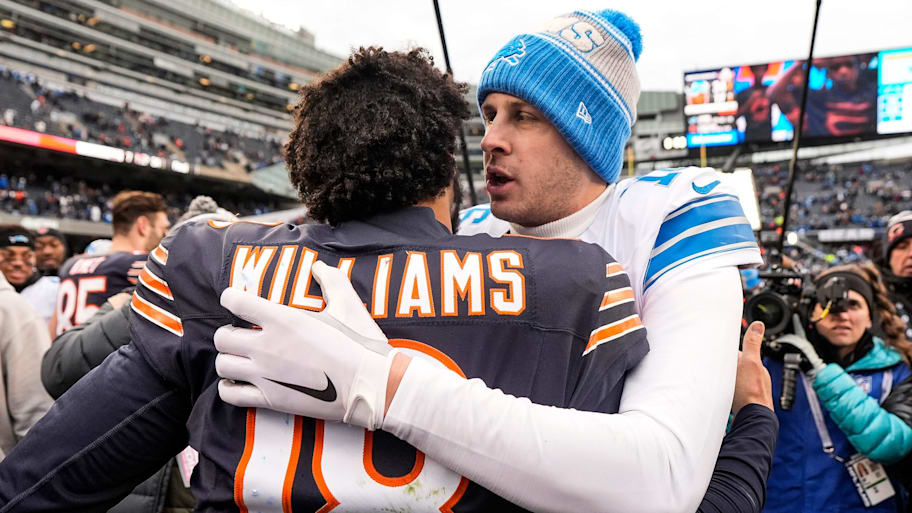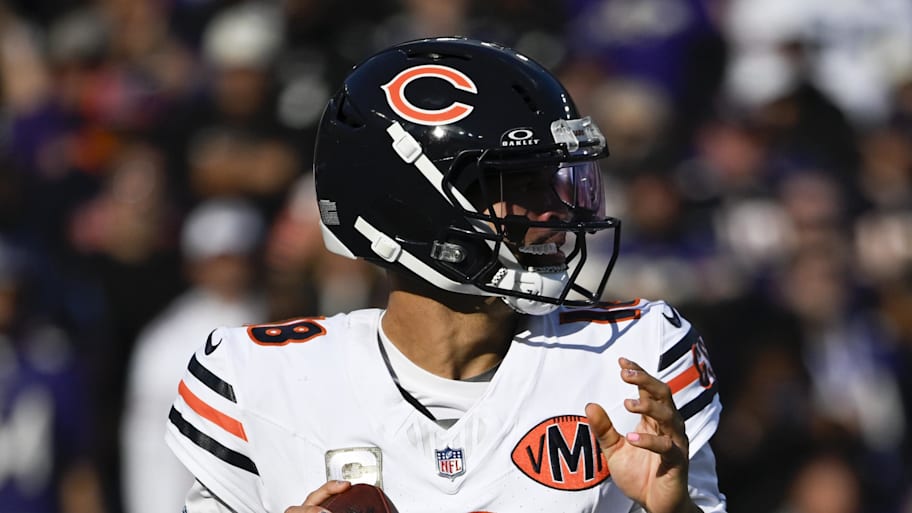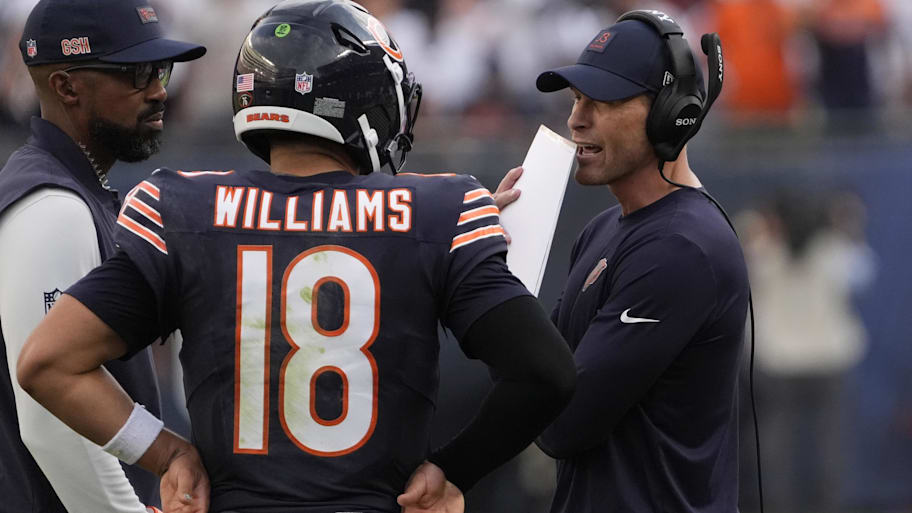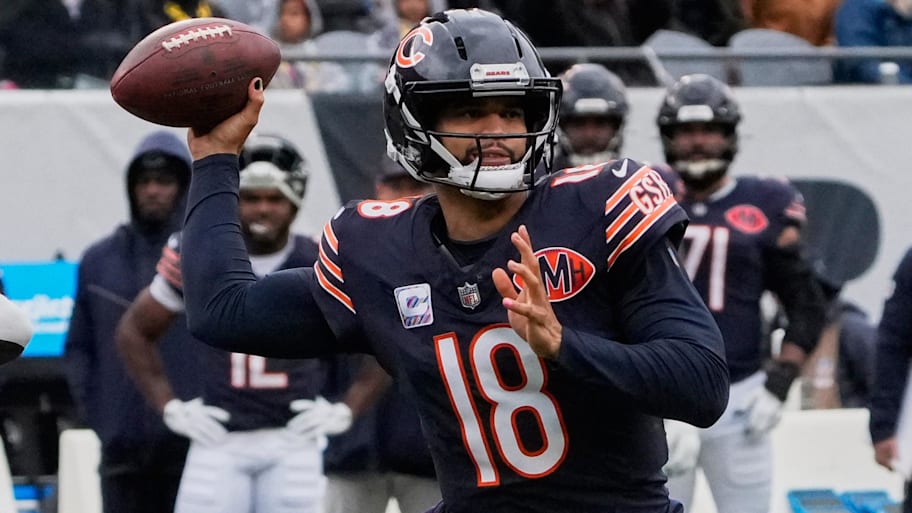In the last 20 years, the Bears have started 21 quarterbacks, which, all by itself, is telling. Look deeper, though. That list includes a Super Bowl winner (Nick Foles), a 38-year-old career backup who got one game (Todd Collins), the second pick in an NFL draft (Mitch Trubisky) and a gunslinger often photographed by paparazzi (Jay Cutler). Only five of those signal-callers surpassed 4,000 passing yards while playing for Chicago, and that list—Kyle Orton, Rex Grossman, Justin Fields, Trubisky and Cutler—isn’t laden with elite players. Cutler might be the only one. He might not even qualify, depending on the evaluation standard of “elite.”
Somebody should draw those names on a Da Bears fan’s T-shirt. They’re approaching Browns quarterback territory.
So, where does current quarterback Caleb Williams fit among them? On that list, in relation to a small sample size, when incorporating his vast potential and new head coach. Where does he fit in the NFL quarterback tiers, period?
The answer, at its most basic, is no answer. It changes every week. That’s because his progress—and Williams has made progress—is best described as uneven and slower than anticipated. Sports Illustrated spoke with four people who evaluate NFL talent and two folks in Williams’s stable of confidants. As might be expected, the takes were generally consistent but split in half, with the camps divided between believers and those starting to doubt Williams as a potential superstar NFL quarterback.
One pro personnel evaluator for an NFC team, when asked to lay out any specific takeaways gleaned from Williams’s performance in a Week 7 win over New Orleans, tapped back over text message: The Bears have a great defense.
Ouch! At least Chicago improved to 4–2 under new head coach (and offensive wizard) Ben Johnson with that victory. An ideal matchup followed last Sunday against Baltimore, its depth decimated by injuries. The Ravens’ defense entered that contest ranked 28th against the pass, 26th against the run and 30th overall, with low pressure and sack rates (28th and 31st, respectively).
Williams made his 24th career start. He had a pair of elite wideouts in DJ Moore and Rome Odunze, an above-average running back in D’Andre Swift, and a below-average offensive line that has struggled consistently throughout this 2025 season. He was also missing a left tackle (Braxton Jones), an above-average tight end (Cole Kmet) and a backup running back (Roschon Johnson). But Williams’s trajectory pointed upward, at least.
Why, then, was this 4–2 record billed as shaky, unsustainable, a … mirage? Well, Chicago started last season with the very same record. The Bears lost 10 consecutive games, from their seventh game onward. And Williams’s improvements so far this season were not what most expected from the top NFL draft pick with arm talent so obvious that even casual football fans could see it leaping from their television screens.
Week 8 only added to the clamor in Chicago, and this obscured any reasonable discussions around Williams’s development, his rapport with Johnson or how he might project in this and future seasons. Week 8 ensured reason would be buried. And there were reasons for that, reasons that made sense. The best quarterback in this game Sunday was Tyler “Snoop” Huntley, a solid backup who has started only 15 NFL games, including this past one. The Bears had won four straight. They did not beat the Ravens, and did not come especially close to winning, even with Lamar Jackson watching from the sideline.
When it ended—in part because of how it ended—Chicago’s streak was over, Williams and Johnson were in a public disagreement over a specific (and back-breaking) fourth-quarter play, and this was one headline from one online outlet: “Caleb Williams Is Truly Awful And It Now Appears Ben Johnson Knows It.”

Williams’s ‘little signs’ of progress
Should anyone decide to compare Williams to that list of Bears starters from the past 20 years, they should understand what two of the evaluators who spoke to SI and both of those in his camp said, independently and consistently. There’s not much to extrapolate yet, which is partly because the Johnson-Williams experiment in offensive football is only eight games old—and partly because the shelf life for elite or even starting-caliber quarterbacks has been longer in recent seasons, with paths once considered disastrous suddenly being resumed.
For those optimistic Chicago sports fans, the more accurate comparisons should center on Jared Goff, Josh Allen, Sam Darnold or Geno Smith. Each was slapped with the dreaded “bust” label. And each became something more, although to varying degrees—Goff and Allen, now perennial MVP candidates; Darnold, playing like one in his first season with the Seahawks; Smith, struggling in Las Vegas but after demonstrating his starter bona fides for years.
That those concerned with Williams’s ability reach for “bust” before those comparisons says more about our media landscape than it does about his on-field play. Which doesn’t invalidate the obvious concerns—he holds the ball too long, often runs too soon and is too inaccurate compared to quarterbacks who win consistently in the NFL.
Those who narrowly define Williams as no more than his flaws see no more than that in his future. And yet, as one scout in Chicago’s division told SI, “You can’t ignore his arm talent, which is exceptional.” Williams, this scout added, was taught to embrace this very trait at every level of football before this one. And, when the Bears drafted him in 2024, the situation he entered wasn’t ideal for his development. It wasn’t satisfactory, even.
Johnson was supposed to fix that, to elevate Williams into another Goff, whom Johnson coached in Detroit to great acclaim for both. But Williams isn’t a veteran, like Goff, when the Rams traded him to the Lions in 2021. To believe the process with Goff could be replicated with Williams in not even half a season, let alone be completed by Week 8, is to believe in fiction.
One person who knows Williams well points to the “little signs” of progress: more buy-in, more check-downs taken, improved diagnosing of defenses, and, for individual plays or drives but not consistently, glimpses of the greatness long expected from him. Now, this person says, the quarterback with elite talent is married to an elite coach.
“You can’t ignore his arm talent, which is exceptional.” An NFC North scout
For better, like all marriages, and for worse. “It’s not going to happen overnight,” this person says. “Just because you paint your fingernails red doesn’t mean you don’t have drive, tenacity, creativity and f---ing talent—or that you don’t want to be great. The bottom line is: The difference-maker is great coaching.”
Speaking specifically of Johnson’s tenure with Goff in Detroit, this person adds, “What drove [him] to succeed with Goff was to prove people wrong, when no one [else] believed. And it’s no different than what’s driving him now.”
This example speaks to the broader, shifting world of the incubation process for prized quarterbacks. Williams is already part of some trends, like the emphasis on beginning development at earlier ages. He played for different colleges. And he played well enough to earn a longer runway, which, in most places, is baked into that kind of lofty draft status, which applies to Allen (seventh, 2018), Darnold (third, 2018) and Goff (first, 2016), especially. They’re blessed and cursed for being selected that high, blessed with time to prove their value. Cursed with inevitably menacing public reaction borne from growing as players on international stages.
The critical element, this person says, is less complex than most believe. “Do they remain open to coaching?” If so, then the blame cast their way can shift, because they’ve proven they’ve left “cesspools.” And because their development often started earlier and was enacted in greater depth, with precision and technique prioritized, many “busts” need different situations and different coaches in which they can thrive.
Is that Williams? Nobody can answer that yet. Not with a straight face. But to affix any negative label to him after 24 total games—and only eight under Johnson’s tutelage—would be equally foolish.

What’s true about Williams and the offense
All things can be true—more than one, at least.
True: Entering Week 8, Johnson emphasized red zone scoring and fundamentals as areas in which the Bears needed to improve.
Also true: Against the Ravens, Chicago scored on one of its three red zone opportunities and amassed 11 penalties for 79 yards.
True: Williams cannot be considered, rationally, as anything near a “bust.” Not yet.
Also true: In some games this season, Williams has already shown glimpses of the future that all involved believe is possible. In Week 2, at Detroit, amid a 52–21 face-stomp by the Lions, Williams made difficult throws and impossible throws without deviating much from Johnson’s game plan. He deployed his athleticism in the right spots. Johnson, speaking to reporters afterward, noted “a number of plays” where Williams’s eyes were positioned incorrectly or he held onto the ball too long. Johnson also said, “I did see significant growth.”
True, amid significant growth, Williams takes longer, on average, to throw a pass, than any other starter in pro football—his average, per Pro Football Focus: 3.23 seconds.
Week 8 brought more of the same, competing truths familiar to anyone who develops football players. They’re necessary for that very development, and they’re also never guaranteed.
True: The Bears drove down the field against that banged-up, putrid Ravens defense on both of Chicago’s first two drives, netting six points combined from both drives down the field.
True: The offense mounted another drive just before the half, leading to a missed field goal.
Also true, II: Part of how Chicago reached the outer-end of its field goal range was Williams’s nifty 22-yard scramble up the field.
Also true, III: An intentional grounding call against him—one of two from Sunday—cost the Bears 10 yards, one down and forced Johnson to use his final first-half timeout (to avoid the 10-second runoff). This meant a 58-yard attempt, rather than a 48-yard one that could have been closer, if not for this specific penalty.
True: Despite those promising drives stalling precisely where the Bears coach said his team needs to stall far less often, Williams fashioned Chicago’s best drive of the day late in the third quarter. Swift was running. Odunze was wiggling up the right sideline. Swift’s touchdown cut Baltimore’s lead to 16–13, despite everything else.
Also true: The Bears’ next possession began with a false start and a stuffed run play. There’s gotta be a metaphor in there. Williams followed that sequence by forcing a pass into coverage, which cornerback Nate Wiggins undercut and snagged.
Which is where Week 8 for Chicago grew more complicated. In the aftermath, Williams described his read as good—favorite target this year, Odunze; the throw itself was not far enough in front of the wideout. Johnson, describing the same sequence, wondered aloud whether a deeper run through Williams’s progression would have netted a better option for that throw.
True: Quarterbacks and those who call plays for offenses disagree about specific throws all over the league every single week.
Also true: Many coaches who see actual progress wouldn’t blast a second-year quarterback like that publicly, fair or not.

Johnson will get ‘that kid playing at a high level’
This Sunday, the Bears will travel to Cincinnati to face the Joe Flacco–led Bengals. The fact that some folks are already considering if Williams can flourish down the road, away from Chicago, does not speak highly of his progress thus far. Nor does the only award Williams has won recently—GQ’s Most Stylish Football Player of 2025 in a fan-voted competition on GQ’s Instagram page. Nor does what Drake Maye is doing in New England or what Jayden Daniels has done in Washington. Nor does this, from Johnson, after the Ravens debacle: “I really put it on the leaders there in that locker room to get this ship going the right direction.”
One Williams confidant sees two realities. Neither is exactly bountiful, at present, but the difference is immense. “This is people trying to not take accountability and blame [him]. You have to marry the right coach with the right player [for the] magic to happen.”
This confidant assesses the calculus, he hopes, for better days ahead. “Ben may be flexing on people and that s---, but he’s gonna figure out how to get that kid playing at a high level. And they’ll be the last ones laughing.”
More NFL on Sports Illustrated
This article was originally published on www.si.com as NFL Talent Evaluators Debate What’s True About Caleb Williams’s Progress.
